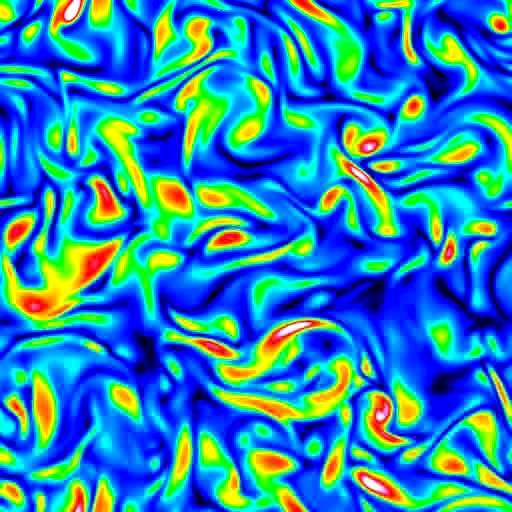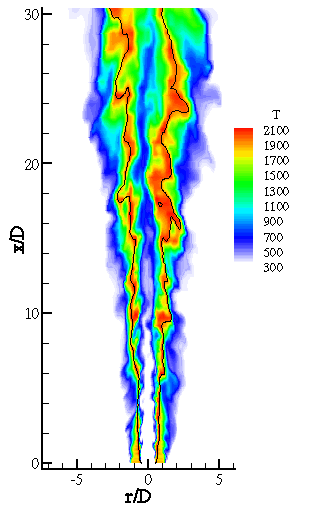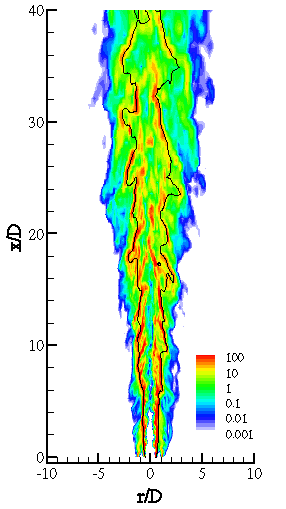Large Eddy Simulation of Premixed and Non-Premixed
Gas Combustion
(Current research in premixed
turbulent reacting flows by
Ed Knudsen and Dirk
Veenema, and non-premixed
turbulent reacting flows by Matthias
Ihme)
Large-eddy simulation (LES) is an approach to solving
turbulent flows in which the larger scales of turbulent motion are exactly resolved
while the smaller scales are modeled. This approach, as compared to the traditional
Reynolds Averaged Navier-Stokes (RANS) method in which all turbulent scales
are modeled, leads to significantly improved results in many real world flows.
Such improvement is due to the resolution of the large turbulent scales. The
chemical reactions that control combustion, however, occur on the smallest scales
of the flow and hence can almost never be fully resolved. As such, modeling
approaches are needed in order to accurately predict the chemical behavior of
reacting flows. Furthermore, different modeling approaches are required in premixed
and non-premixed combustion.
In premixed combustion, fuel and oxidizer
enter reaction zones already mixed. Such flows occur in a host of industrially
relevant applications, ranging from kitchen stove top burners to spark ignition
internal combustion engines and gas turbines. Chemistry models for this type
of combustion most often involve tracking the location of the flame front, which
is typically very thin relative to the geometry of the burner. Such tracking
can be accomplished by solving a levelset equation, the G-equation, that describes
the front. This equation requires information about the flame's burning velocity,
which must be modeled. Research in this area focuses on improving models for
the turbulent burning velocity and on improving the accuracy of the numerical
methods used to solve the levelset equation.
Non-premixed combustion occurs in applications
such as diesel engines and aircraft engines. In such cases, where diffusive processes
are controlling, chemistry can only be exactly determined by solving a large
multidimensional space involving hundreds of chemical species. Current models
overcome this difficulty by assuming that this space can be characterized by
a much smaller number of dimensions. Specifically, two dimensional manifolds
consisting of a mixture fraction variable and the scalar dissipation rate or a reaction
progress variable are often used.
Such models can be developed by using the laminar flamelet concept. To account for partially premixed fuel,
local extinction, re-ignition, and better pollution modeling, a more detailed
description of the chemistry is needed. Several novel combustion models are
being developed to tackle this complex phenomena.
|
|
Color: Temperature
Black Line:
Flame front
Click image
to see animation.
Temperature contours in a large eddy simulation
of the F3 flame studied
by Chen, et al (1996). F3 is a stoichiometric premixed methane / air
flame where Re = 23,400. A pilot flame is used for stabilization. The
black contour line represents the flame front, which was tracked using
the G-equation.
(Provided by Ed
Knudsen)
|
|
|
Large Eddy Simulation of a Reacting Spray
Experiment
Large Eddy Simulation (LES) of a reacting spray
experiment. Temperature and axial velocity contours, drop position (~1.6
millions droplets).
Click image
to see full size.
(Provided by Olivier
Desjardins)
|
|
|
DNS of Isotropic Decaying Turbulence
DNS of isotropic decaying turbulence, with
vorticity contours plotted; Re_lambda=67.
Click image
to see movie.
(Provided by Olivier
Desjardins)
|
|
|
|
|
|
Color: Temperature Distribution
Black Line: Contour of Stoichiometric Mixture Fraction
Click image
to see animation.
|
|
|
Color: Scalar Dissipation
Rate
Black Line:
Contour of Stoichiometric Mixture Fraction
Click image
to see animation.
|




